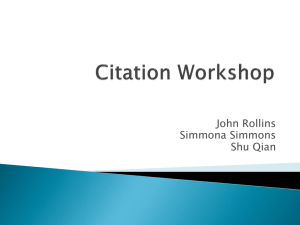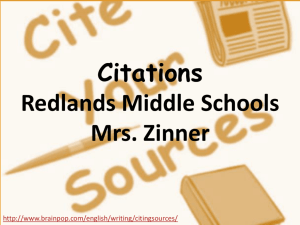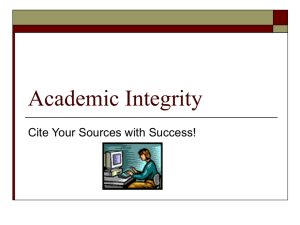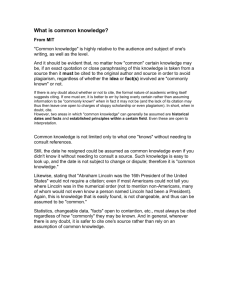Plagiarism - Lake-Lehman School District
advertisement
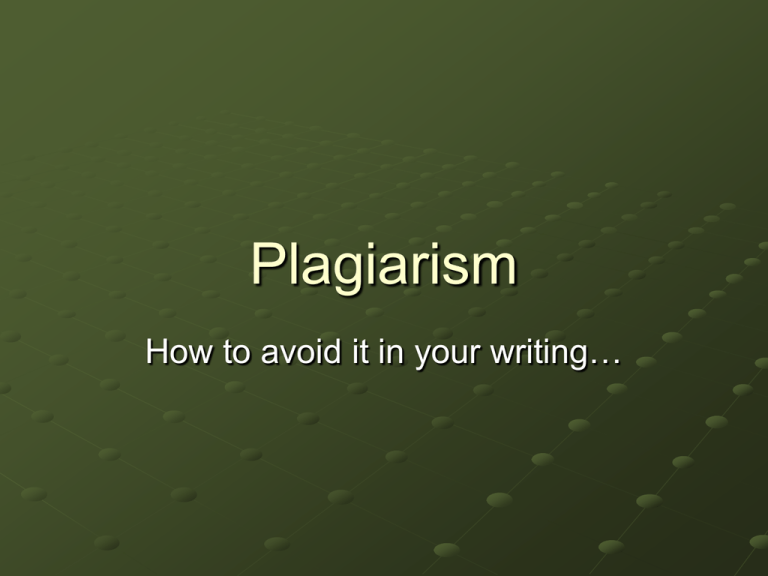
Plagiarism How to avoid it in your writing… What is it? According to the American Heritage Dictionary of the English Language, to plagiarize is to: “Steal and use the writings of another as one’s own”. Even if you don’t mean to, if you present someone else’s thoughts, ideas, or information without giving them credit, you are committing academic dishonesty. Penalties There are many penalties for plagiarism, and most often they vary depending upon the grade level, school, and degree of dishonesty. For Lake-Lehman, the penalties are as follows: Automatic zero for the assignment Required to complete the assignment properly for no credit Notification to parent/guardian Notice placed in permanent student file Possible detention, etc. Penalties It is important that you remember that when you are writing a research paper, your teacher will assume that any information NOT cited (or given credit) is your own. If you pass off someone else’s ideas as your own, even if it is done on accident, you have plagiarized. Though the penalties at Lehman may appear harsh, students at colleges and universities have been kicked out of the institution for plagiarizing, and journalists have been fired from their jobs. Food for thought… Why do we have to worry about plagiarism so much in this course? What are the rules for plagiarism in other courses at LL? What do we do when we are using the Internet? What do we do when we are using a print source, like a book, magazine, newspaper? Do the same rules apply for visual information, like pictures, charts, and graphs? How can we avoid it? To avoid plagiarism, you must give credit whenever you use: Another person’s idea, opinion, or theory Any facts, statistics, graphs, drawings--any pieces of information--that are not common knowledge. Quotations of another person’s actual spoken or written words. Paraphrase of another person’s spoken or written words. Summaries of another person’s spoken or written words. How can we avoid it? Strategies for Avoiding Plagiarism: Put in quotations everything that comes directly from the text especially when taking notes. Paraphrase, but be sure you are not just rearranging or replacing a few words. Instead, read over what you want to paraphrase carefully; cover up the text with your hand, or close the text so you can't see any of it (and so aren't tempted to use the text as a "guide"). Write out the idea in your own words without peeking. Check your paraphrase against the original text to be sure you have not accidentally used the same phrases or words, and that the information is accurate. Always, always, always proofread your work! Examples… Take a look at your worksheet. See if you can distinguish what makes each sample paraphrase good or bad. Which one is plagiarized? Common Knowledge You do NOT have to document common knowledge. Common knowledge is any information that your readers will likely know without reading your paper. It is any piece of information that you were aware of prior to conducting any research on your topic. It does NOT have to be cited, because it came from your mind, based upon your knowledge of your topic. How can we tell if it’s common knowledge? Material is probably common knowledge if . . . You find the same information undocumented in at least five other sources You think it is information that your readers will already know You think a person could easily find the information with general reference sources. The facts can be found in numerous places and are likely to be known by a lot of people. Example: John F. Kennedy was elected President of the United States in 1960. This is generally known information. You do not need to document this fact. However, you must document facts that are not generally known and ideas that interpret facts. Example: According the American Family Leave Coalition's new book, Family Issues and Congress, President Bush's relationship with Congress has hindered family leave legislation (6). The idea that "Bush's relationship with Congress has hindered family leave legislation" is not a fact but an interpretation; consequently, you need to cite your source. You do NOT need to document information that has become general knowledge by being reported over and over again in many different sources. Example: Michael Jordan holds several NBA scoring records. When all else fails…. GIVE CREDIT! Let’s see if we can detect it… Are these facts common knowledge? OJ Simpson was acquitted of criminal charges for the murder of his wife. World War II began in 1939 and ended in 1945. Research from the Human Genome Project estimates that human beings have approximately 50,000 genes Currently, the fastest growing group of Web users is comprised of women over the age of 55. Abraham Lincoln was the 16th president of the United States of America. Many literary critics believe that the novelist Virginia Woolf drew extensively from her own experiences for the central character in her novel, Mrs.Dalloway In the Northern Hemisphere, the summer solstice takes place on June 21st. There are 5,283 hospice programs in the United States. The freezing point of water is 32 degrees Fahrenheit or 0 degrees Centigrade The teen pregnancy rate in the United States fell 8 percent from 1995 to 1997. When do we document? Do we need to give credit to the following? Why or why not? You are writing new insights about your own experiences. You are using an editorial from your school's newspaper with which you disagree. You use some information from a source without ever quoting it directly. You have no other way of expressing the exact meaning of a text without using the original source verbatim. You mention that many students in your grade belong to different clubs. You want to begin your paper with a story that one of your classmates told about her experiences in Bosnia The quote you want to use is too long, so you leave out a couple of phrases. You really like the particular phrase somebody else made up, so you use it. Are there other types of plagiarism? There are three more varieties of plagiarism that you must avoid. They are: Self-Plagiarism: submitting a paper that you have submitted in a previous class. Copying all or part of another student’s paper: a student who offers to share papers, journal entries, homework assignments, and the like does you a great disservice. These are acts of academic dishonesty and are likely to incur penalties for both parties. Collaborative efforts, unless the teacher says it is ok: unless you are allowed to work with another person, you must work alone on your assignments. Collaborative efforts where the teacher has not permitted such work results in academic dishonesty. Let’s Review… Five simple rules for avoiding plagiarism: Rule 1: A fact that is NOT common knowledge must have a citation Rule 2: When you write about an idea, you must make clear whose idea it is. If it is your own idea, you do NOT cite the source. Rule 3: If you are writing about someone else’s idea, you must cite your source. Rule 4: If you use someone else’s exact words, you must put them in quotation marks and give credit to the speaker as well as cite the source. Rule 5: When you use an author’s idea without quoting exactly, you must write the idea in your own words (paraphrase), not just rearrange or change a few of his/her words, and you MUST cite the source. In Summary… Well-known facts require no citation Your own ideas require no citation. You must cite the source of someone else’s ideas, facts, and opinions. Using someone else’s exact words requires quotation marks and citation of the source as well as credit to the speaker of the quote. Using an author’s idea but not quoting it exactly requires a thorough paraphrase, not just a rearrangement of words, and citation of the source. And most importantly…. WHEN IN DOUBT…..ALWAYS GIVE CREDIT!!
